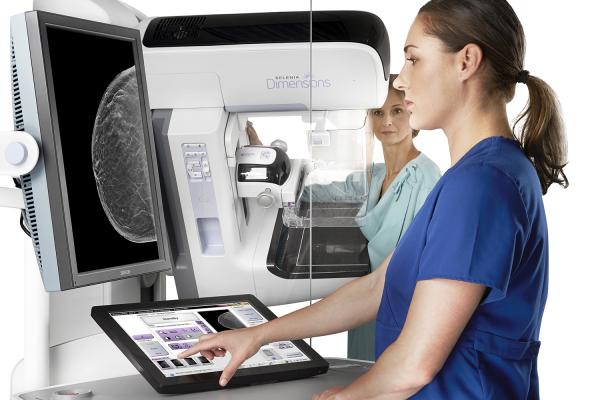
October 21, 2015 – An updated breast cancer screening guideline from the American Cancer Society (ACS) recommends that women at average risk start regular annual mammography screening at age 45 and transition to screening every two years starting at age 55. The guideline supports informed decision-making for women ages 40 to 44, who should have the option to begin screening early, and for women 55 and older, who should have the opportunity to continue screening every year if they choose. It is being published in the Journal of the American Medical Association.
The guideline is the first created since the ACS incorporated Institute of Medicine standards into its guideline development protocol to ensure a more rigorous and transparent process for developing and communicating guidelines.
“These recommendations are made with the intent of maximizing reductions in breast cancer mortality and years of life saved while being attentive to the need to minimize harms associated with screening,” said Kevin Oeffinger, M.D., chair of the breast cancer guideline panel and a family physician at Memorial Sloan Kettering Cancer Center. “The benefits, burdens and judgment about that balance differ depending on a woman’s age, health, values and preferences. These recommendations recognize and reflect those differences.”
The guideline recommends:
- All women should become familiar with the potential benefits, limitations and harms associated with breast cancer screening;
- Women with an average risk of breast cancer should undergo regular screening mammography starting at age 45 (strong recommendation);
- Women who are 45 to 54 years old should be screened annually (qualified recommendation);
- Women who are 55 and older should transition to biennial screening or have the opportunity to continue screening annually (qualified recommendation);
- Women should have the opportunity to begin annual screening between the ages of 40 and 44 (qualified recommendation);
- Women should continue screening as long as their overall health is good and they have a life expectancy of 10 years or more (qualified recommendation); and
- The ACS does not recommend clinical breast examination for breast cancer screening among average-risk women at any age (qualified recommendation).
A strong recommendation conveys the consensus that the benefits of adherence to that intervention outweigh the undesirable effects that may result from screening.
Qualified recommendations indicate there is clear evidence of benefit of screening but less certainty about the balance of benefits and harms, or about patients’ values and preferences, which could lead to different decisions about screening.
“This guideline relies on the best evidence to offer new, more precise guidance taking into account a woman’s age, health, and personal values and preferences.” said Elizabeth "Terry" Fontham, founding dean of the School of Public Health at Louisiana State University (LSU) Health Sciences Center in New Orleans and chair of the ACS Guideline Development Group (GDG). “Though the evidence shows that there are some benefits from mammography screening starting at age 40, those benefits more clearly outweigh the harms from age 45 onward. Still, some women will choose to begin screening between age 40 and 44, both because they are concerned about their risk of breast cancer, either in general or because they are at higher risk, and are less concerned about the chances of experiencing a false positive findings. Those women should have the opportunity to start screening at 40 if they choose.”
The guideline was developed by the GDG, a panel of generalist clinicians, biostatisticians, epidemiologists, economists and patient representatives convened by the American Cancer Society. The GDG commissioned a systematic review of the evidence by an independent center, the Duke University Evidence Synthesis Group, to inform the recommendations process.
Based on that evidence review, the panel concluded that there is a benefit from screening with mammography for women in their early 40s, but that risk is lower and harms, primarily from false positives, are somewhat greater for women ages 40-44 than for women in older age groups. Nonetheless, the GDG recognized that some women will choose to accept the harms from screening as a reasonable trade-off for the benefits.
“The option to screen every two years for women beginning at age 55 is based on the fact that post-menopausal breast cancers tend to develop more slowly,” said Oeffinger. “Because of that, women may choose either to continue annual screening or move to screening every two years beginning at age 55. Breast cancers before menopause tend to grow more rapidly, making screening every year important.”
The panel notes that efforts are underway to reduce false positives, including studies to improve the quality of mammography interpretation. Tomosynthesis, also known as 3-D mammography, may also improve outcomes while reducing false positives, but there was too little data at the time the evidence review was initiated to include comparisons with 2-D mammography. Molecular biomarkers may also help better predict progression, lessening the likelihood of overtreatment. The panel also noted that barriers still exist that prevent many low-income, uninsured women or those without a usual source of care from having access to high-quality screening.
The evidence review also found a lack of evidence showing benefit from routine clinical breast exams (CBE), and moderate evidence that doing CBE along with mammography increases the rate of false positives. Based on this information, the GDG did not recommend CBE. Still, the new recommendation does not discount the potential for CBE to be valuable in low resource settings outside the United States where mammography screening is not feasible.
For more information: www.cancer.org


 April 18, 2024
April 18, 2024 








